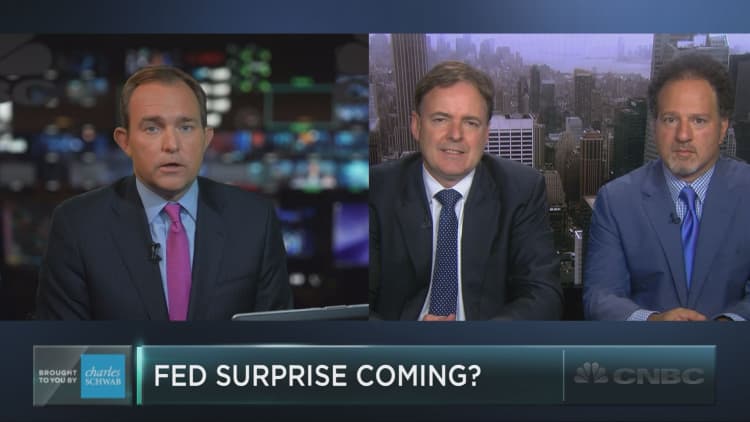In the Fed's release Wednesday there will be one chart that has the power to rock the markets — though it probably will not.
That's the Fed's interest rate forecast, commonly known as the "dot plot."
The chart shows the anonymous interest rate forecasts of Fed officials, and it's used by the market to determine where the central bank believes rates are going, including its longer-term neutral rate.

The problem is the Fed and the markets don't see eye to eye on the outlook for interest rates. The Fed forecast, last updated in June, shows it expects two hikes to the federal funds rate this year, after beginning 2016 projecting four rate increases.
It still has four for next year and the year after. Many economists expect those forecasts to slip back to just one hike for this year and some say it's more likely there will be just three increases in each of the next two years.
"The information value is low in this. They've just been proven incorrect so many times," said John Briggs, head of strategy at RBS.
The Fed is not expected to take action on rates when it winds down its two-day meeting Wednesday afternoon. But the 2 p.m. EDT statement could provide some guidance on how it sees the economy and how it feels about hiking rates later in the year. Economists mostly expect the next rate increase in December.
The central bank also will project the neutral rate, where it eventually sees the fed funds target heading. That was just above 3 percent in June, but economists now say that's a number that could drop.
"It has been coming down consistently," said Diane Swonk, CEO of DS Economics. "The Fed has consistently been lowering the terminal rate and lowering its trajectory. The markets have been more accurate than the Fed which we know, but that doesn't mean they will continue to be that way."
Swonk said she'd like to see the Fed move away from the "dot plot." "I think they add more confusion than clarity because there's such a dispersion. It's not clear how much it represents a consensus of what the Fed expects," Swonk said.
She said the Fed could leave the dots on its target for next year. "If they don't go in September, some may want to keep four for next year, and others may say, 'Hey I think we just lowered the trajectory.'"
Swonk said one official could skew the outlook, such as former Minneapolis Fed President Narayana Kocherlakota, who had a negative dot in his forecast last year. St. Louis Fed President James Bullard also impacted the dot plot when he revealed he put down only one more interest rate increase through 2018.
This is what to watch when the "dot plot" is released Wednesday. The number of Fed officials that now expect one rate hike should move higher if the central bank holds rates steady at this meeting, as expected. It has only raised rates once in the last 10 years, and the fed funds target is now at about 0.375 percent.
That means under 2016, the number of dots on the chart, or Fed officials, should fall to the line between a half percent and 0.75 percent rate level. That would therefore point to the one rate hike expected in December by many economists.
The 2017 dots should also shift lower, to account for just one hike in 2016. If Fed officials change their view about four rate hikes for next year, the dots could move lower and gravitate toward 1.25 and 1.5 percent. Should they also expect just three hikes in 2018, the dots should move down to the 2 to 2.25 percent area.
"They could go less than that if they talk about the neutral rate being lower," said Scott Anderson, chief economist at Bank of the West.
"It would be a dovish surprise if they had just two hikes for next year," he said.
Anderson said the neutral rate, or terminal rate, is where the Fed views rates as being back in balance. "It's where they think monetary policy is no longer stimulative, not necessarily a tightening of policy. It's where the long term equilibrium should be for the fed funds rate," he said.
Of course, none of this includes any significant changes in the economic outlook, or whether a new president in 2017 will bring fiscal stimulus back into the equation. If that should mean the creation of more debt or even more growth, that could turn the long-term dot plots upside down.


